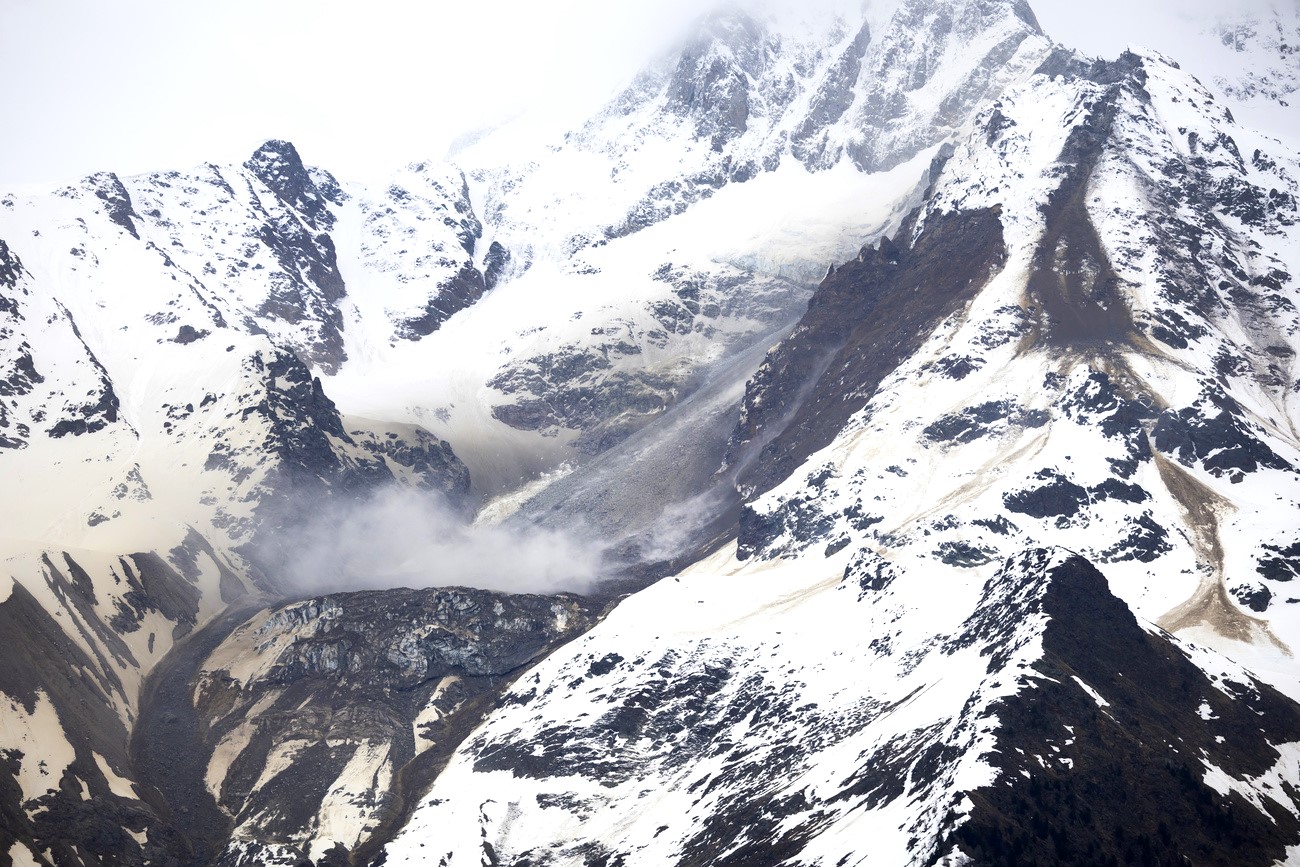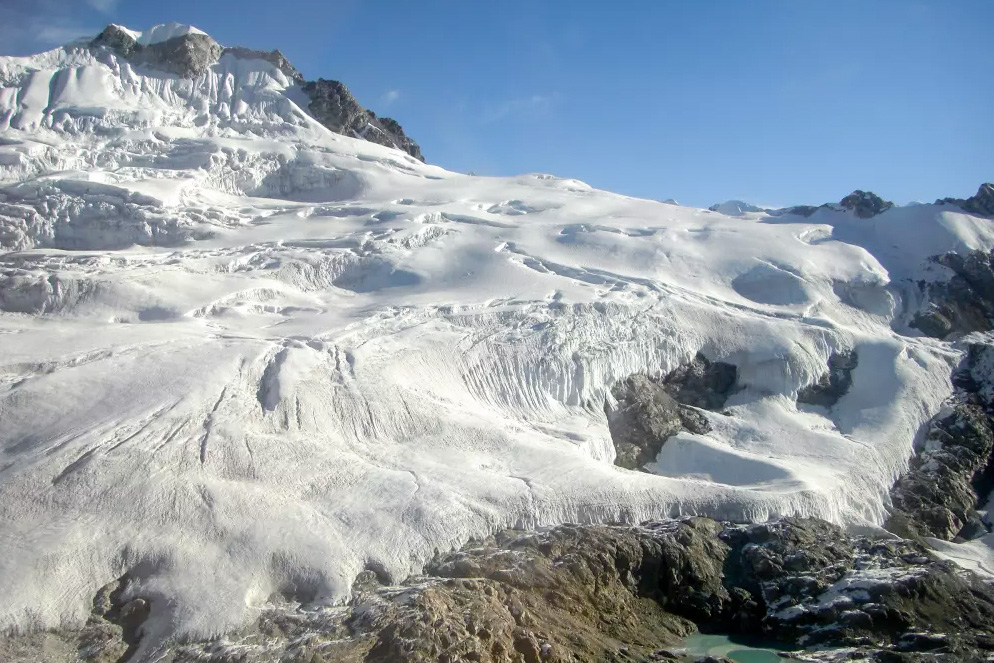
Saving lives in the shadow of melting giants

Pierre-Yves Pitteloud, regional disaster risk reduction adviser for the Swiss Agency for Development and Cooperation (SDC) in India, tells Swissinfo about Switzerland’s expertise in disaster prevention and why international cooperation matters.
In late May, a dramatic glacier collapse in the Swiss Alpine village of Blatten grabbed international headlines – but the story behind the scenes was just as powerful: thanks to Switzerland’s monitoring system for natural disasters, the village was evacuated in time, and lives were saved.
“We were able to predict the movement of the glacier and the impending disaster with remarkable accuracy,” Pierre-Yves Pitteloud said. “But this wasn’t just Swiss ingenuity – it was the result of international collaboration.”

Switzerland collaborates with, among others, teams of European, American and Indian scientists to monitor its glaciers. Expertise and data are shared to best predict natural disasters and save lives.

More
Why do Swiss mountains collapse? It’s complicated
Pitteloud serves as the SDC’s regional adviser for disaster risk reduction in India. He recently shared his insights during a disaster prevention conference in Geneva, co-hosted by Switzerland and the UN Office for Disaster Risk Reduction (UNDRR). He sees a clear parallel between Switzerland’s Alps and India’s Himalayas – and a shared responsibility to act.
Launched in 2022 by UN Secretary-General, António Guterres, Early Warnings for AllExternal link is an initiative to ensure that the world’s population is protected from hazardous weather, water, or climate events through life-saving early warning systems by the end of 2027.
Several scientists involved directly or indirectly in monitoring the glacier above Blatten also participate in SDC projects in the Himalayas, under threat of melting glaciers as global temperatures rise. One of the regions covered by the projects is Sikkim, a northeastern Indian state bordering Nepal, China, and Bhutan. The goal of the collaboration is to monitor and address glacial lake outburst floods, also called GLOFs.
The disaster in Blatten was not a GLOF, but early warning systems and preparedness are similar to that of a glacier collapse.

More
Why melting glaciers affect us all
These collaborative mitigation strategies for glacial lakes, which include early warning systems and mapping, have existed for decades in Switzerland.
When glaciers give way
“A GLOF is like a mountain tsunami,” Pitteloud said.
As glaciers recede, meltwater pools form behind natural dams created by moraines. If these fragile barriers give way, millions of cubic metres of water can burst downhill without warning.
This is what happened in Sikkim in October 2023 at the South Lhonak glacial lake.

Research showed that heavy rains triggered a landslide that dumped almost 15 million cubic metres of debris into the lake. This created a wave up to 20 metres high, and a resulting flood eroded the moraine by releasing about 50 million cubic metres of water – enough to fill 20,000 Olympic swimming pools – into the valley.
The flood destroyed five hydropower plants, displaced 28,000 people and claimed at least 55 lives.
According to Pitteloud, the flood was felt hundreds of kilometres downstream in neighbouring Bangladesh.

More
Nepal and the Himalayas, the agony of glaciers on the roof of the world
Together with Indian authorities, the SDC has since installed a monitoring system at the lake. “We set up a weather station, and two cameras monitor ground movement,” Pitteloud said. “We also placed a probe in the lake that measures water levels. Sudden changes can signal a possible outburst. When that happens, the probe sends an automatic alert to the authorities.”
The use of satellites
The SDC’s cooperative project in Sikkim involves universities and research institutes in Switzerland and India, as well as local national and regional authorities. Private companies are also involved. The SDC also trains scientists in other parts of India, and that knowledge is shared with the team in Sikkim.
A Swiss firm commissioned by the SDC produces a report every two weeks on the South Lhonak Lake’s unstable and shifting shores to assess risk.
Since the lake lies at 5,500 metres above sea level with no internet connectivity, satellite data is used. Scientists from the Swiss Federal Institute for Forest, Snow and Landscape Research (WSL) train Indian professionals in using satellite data and computer models to identify natural hazard risks.
“Radar satellite reconnaissance can measure ground deformation down to the centimetre,” Pitteloud said. “This is especially promising when combined with artificial intelligence. The Himalayan region is vast, and you can’t set up stations everywhere.”
This involves international partnerships using European, American and Indian satellites. Through this collaboration, Switzerland gains access to new technologies, Pitteloud noted, and universities can apply satellite tools to similar phenomena, such as the glacier collapse in Blatten.

“But there’s no technological magic wand that can replace local knowledge,” he stressed. That’s why community engagement is key. This enables scientists to correctly interpret the insights provided by the data. The SDC’s partners in Nepal, for instance, interviewed older villagers about their memories of former topography and lake characteristics. The goal was to identify areas of potential hazard and monitor them more closely.
When the 2023 GLOF occurred, Indian border guards patrolling near the Tibetan border were the first to recognise the threat and raised the alert via satellite phone. “That saved lives,” Pitteloud said.
Sikkim now has a monitoring system but not a formal early warning system.
That’s the next step the SDC is working on with the local authorities: standardised operating procedures (SOPs). These include what to do when a siren sounds, where to evacuate, and how to coordinate emergency response and medical aid.
The importance of mitigation
In Switzerland, natural hazard considerations have long been part of infrastructure planning, especially in Alpine regions.
In Sikkim, however, the full economic impact of the disaster wasn’t initially factored into recovery plans. While destroyed homes were counted, the months-long road closures and tourism revenue losses weren’t. Pitteloud says this oversight is changing.

Early warning can save lives, but if people are left stranded by destroyed roads or lose access to power and water, they still face risks. Traditionally, roads in Sikkim were built along rivers, which makes them susceptible to floods, GLOFs and landslides.
Now, Indian authorities are considering these vulnerabilities when rebuilding roads, aiming to minimise or prevent future damage by floods. “Our Indian partners now say that investing in disaster preparedness is especially worthwhile,” Pitteloud said. The goal is not to have to rebuild after every natural event.
Edited by Virginie Mangin/ts

In compliance with the JTI standards
More: SWI swissinfo.ch certified by the Journalism Trust Initiative

















![The four-metre-long painting "Sonntag der Bergbauern" [Sunday of the Mountain Farmers, 1923-24/26] had to be removed by a crane from the German Chancellery in Berlin for the exhibition in Bern.](https://www.swissinfo.ch/content/wp-content/uploads/sites/13/2025/12/01_Pressebild_KirchnerxKirchner.jpg?ver=8f77363a)











You can find an overview of ongoing debates with our journalists here . Please join us!
If you want to start a conversation about a topic raised in this article or want to report factual errors, email us at english@swissinfo.ch.